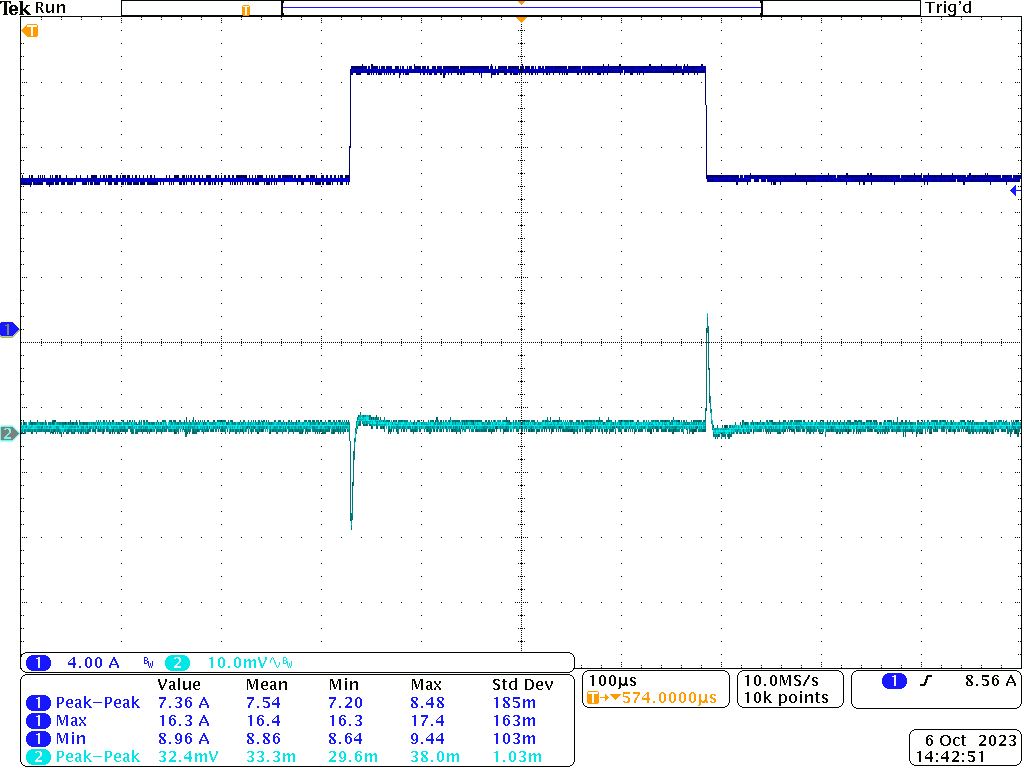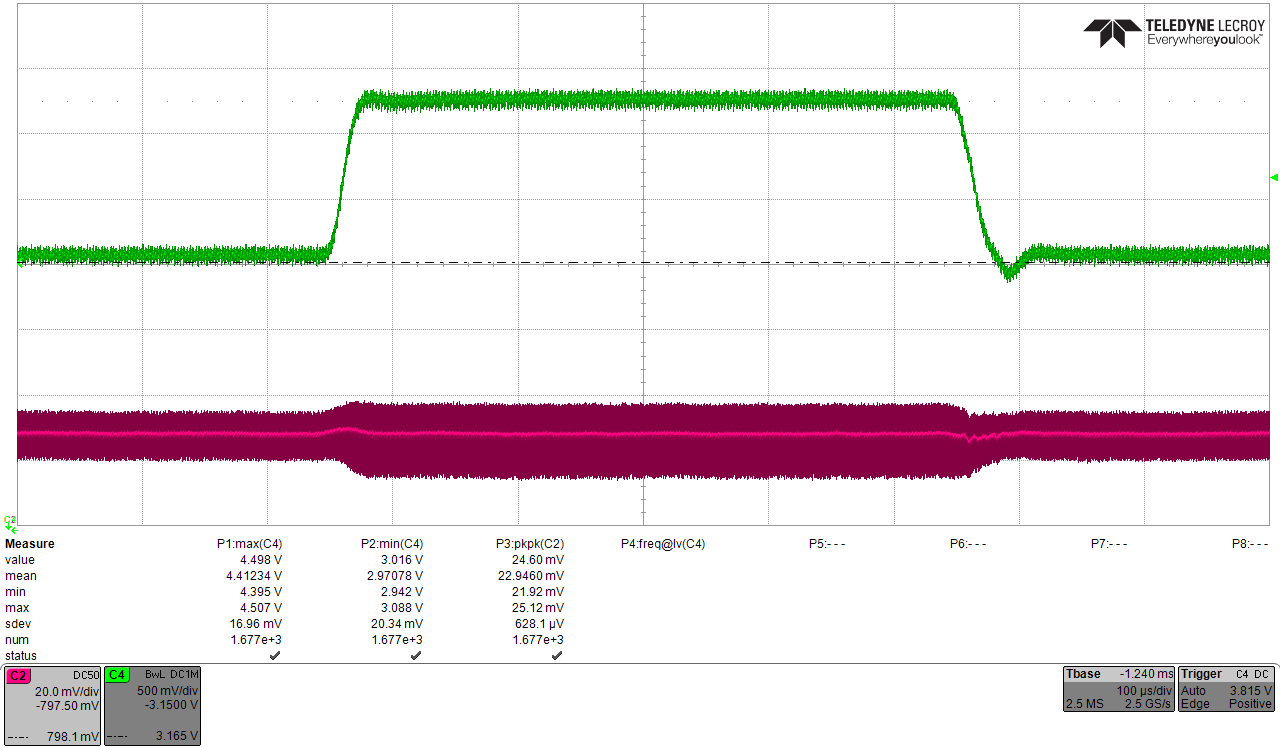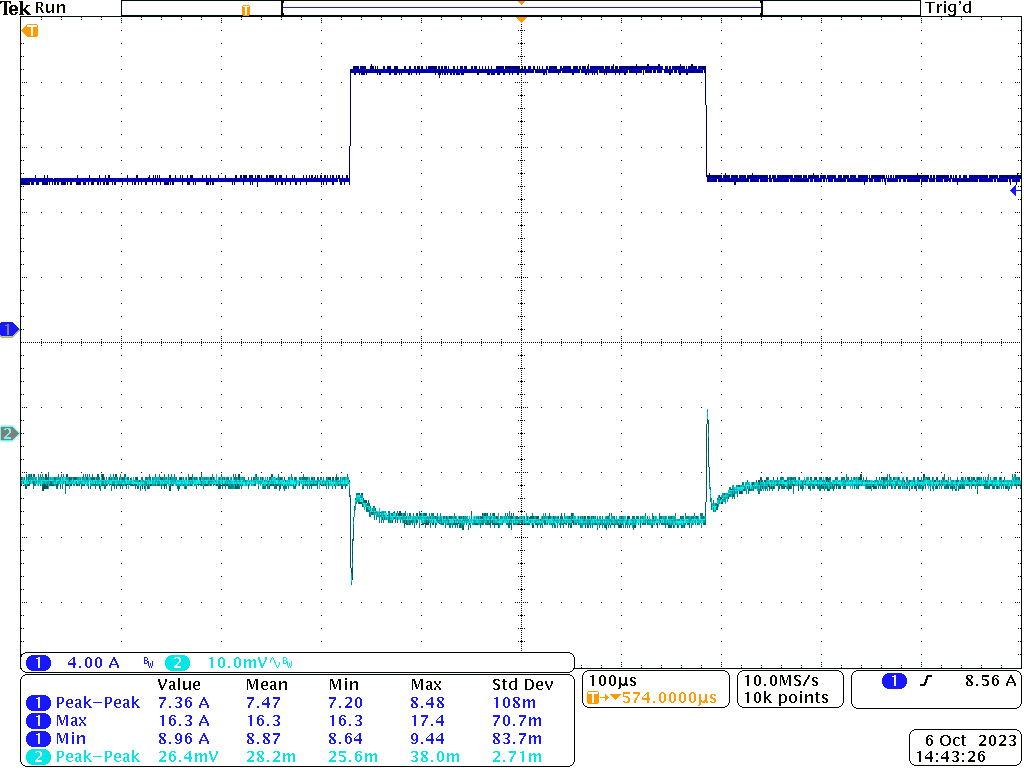SLVSGG8A November 2023 – July 2024 TPS6287B10 , TPS6287B15 , TPS6287B20 , TPS6287B25
PRODMIX
- 1
- 1 Features
- 2 Applications
- 3 Description
- 4 Device Options
- 5 Pin Configuration and Functions
- 6 Specifications
- 7 Parameter Measurement Information
-
8 Detailed Description
- 8.1 Overview
- 8.2 Functional Block Diagram
- 8.3
Feature Description
- 8.3.1 Fixed-Frequency DCS-Control Topology
- 8.3.2 Forced-PWM and Power-Save Modes
- 8.3.3 Transient Non-Synchronous Mode (optional)
- 8.3.4 Precise Enable
- 8.3.5 Start-Up
- 8.3.6 Switching Frequency Selection, Only Applies to TPS6287BxxJE2
- 8.3.7 Output Voltage Setting
- 8.3.8 Compensation (COMP)
- 8.3.9 Mode Selection / Clock Synchronization (MODE/SYNC)
- 8.3.10 Spread Spectrum Clocking (SSC)
- 8.3.11 Output Discharge
- 8.3.12 Undervoltage Lockout (UVLO)
- 8.3.13 Overvoltage Lockout (OVLO)
- 8.3.14 Overcurrent Protection
- 8.3.15 Power Good (PG)
- 8.3.16 Remote Sense
- 8.3.17 Thermal Warning and Shutdown
- 8.3.18 Stacked Operation
- 8.4 Device Functional Modes
- 8.5 Programming
- 9 Device Registers
-
10Application and Implementation
- 10.1 Application Information
- 10.2 Typical Application
- 10.3 Typical Application - TPS6287BxV Devices
- 10.4 Typical Application Using Two TPS6287B25 in a Stacked Configuration
- 10.5 Typical Application Using Three TPS6287B25 in a Stacked Configuration
- 10.6 Power Supply Recommendations
- 10.7 Layout
- 11Device and Documentation Support
- 12Revision History
- 13Mechanical, Packaging, and Orderable Information
Package Options
Mechanical Data (Package|Pins)
- RZV|24
Thermal pad, mechanical data (Package|Pins)
Orderable Information
10.2.3 Application Curves

| VIN = 5.0V | FPWM | TA = 25°C |

| VIN = 3.3V | FPWM | TA = 25°C |

| VIN = 5.0V | Nat. convection | TJMAX = 125°C |

| VIN = 5.0V | FPWM; TPS6287B25 droop disabled | VOUT = 0.4V |

| VIN = 5.0V | FPWM; TPS6287B25 droop disabled | VOUT = 0.8V |

| VIN = 5.0V | FPWM; TPS6287B25 droop disabled | VOUT = 1.675V |

| VIN = 3.3V | FPWM; TPS6287B25 droop disabled | VOUT = 0.4V |

| VIN = 3.3V | FPWM; TPS6287B25 droop disabled | VOUT = 0.8V |

| VIN = 3.3V | FPWM; TPS6287B25 droop disabled | VOUT = 1.675V |

| VOUT = 0.75V | PWM | TA = 25°C |
| VIN = 5V | RLOAD = 66mΩ |

| VOUT = 0.75V | PWM, TPS6287B25 droop disabled | TA = 25°C |
VIN = 3.3V | Iout = 8.75A to 16.25A to 8.75A | |

| VOUT = 0.75V | FPWM | TA = 25°C |
VIN = 3.0V to 4.5V to 3.0V | IOUT = 16.25A | |

| VIN = 5.0V | FPWM | TA = 85°C |

| VIN = 3.3V | FPWM | TA = 85°C |

| VIN = 3.3V | Nat. convection | TJMAX = 125°C |

| VIN = 5.0V | FPWM; TPS6287B25 droop enabled | VOUT = 0.4V |

| VIN = 5.0V | FPWM; TPS6287B25 droop enabled | VOUT = 0.8V |

| VIN = 5.0V | FPWM; TPS6287B25 droop enabled | VOUT = 1.675V |

| VIN = 3.3V | FPWM; TPS6287B25 droop enabled | VOUT = 0.4V |

| VIN = 3.3V | FPWM; TPS6287B25 droop enabled | VOUT = 0.8V |

| VIN = 3.3V | FPWM; TPS6287B25 droop enabled | VOUT = 1.675V |

| VOUT = 0.75V | PWM | TA = 25°C |
VIN = 3.3V | Iout = 11.3A | |

| VOUT = 0.75V | PWM, TPS6287B25 droop enabled | TA = 25°C |
VIN = 3.3V | Iout = 8.75A to 16.25A to 8.75A | |